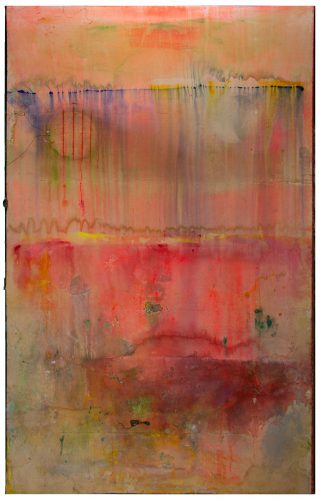Guyana-born artist Frank Bowling OBE RA has been awarded a knighthood in the Queen of England’s Birthday Honours
Sir Frank, 86, who was born in Bartica in then British Guiana, was conferred with the honour of Knight Bachelor in the Birthday 2020 Honours List, which recognises the achievements of a wide range of extraordinary people across the United Kingdom.
A statement from public relations agency Pelham Communications said Sir Frank’s relentless pursuit of excellence in painting during his six-decade long career underpins a lifetime of service to British art.

“Trained in the English art school tradition, my identity as a British artist has always been crucial to me and I have viewed London as my home since arriving in 1953 from what was then British Guiana. To be recognised for my contribution to British painting and art history with a knighthood makes me extremely proud. Friends and family have played a role in my studio since the 1960s – as a husband, father, grandfather and recently a great-grandfather, I am honoured to sit at the centre of a modern family to whom I feel much gratitude,” Sir Frank was quoted as saying.
He also said: “I’ve set out on a quest to explore the possibilities of paint, and I find myself making something new every time. I have an insatiable determination to experiment with colour, form and process, to create new and original artworks that push the boundaries of the medium, while being intellectually grounded in post-war abstraction. The things that paint can achieve are so vast and diverse that I don’t think I’ll ever be done with it.”
The statement noted that despite his age Sir Frank is still is an active painter with an irrepressible work ethic, which finds him working in his studio almost every day.
Last year, a major retrospective of his work, “The Possibilities of Paint Are Never-Ending,” was staged at London’s Tate Britain gallery, which showcased some of his large-scale abstract pieces.
At the time, Sir Frank was said to be troubled by back pain and diabetes and as a result he had taken to painting by using a laser pointer to direct his grandson, Frederik, where and how to pour the paint.
In the statement, Bowling’s family expressed delight at his being recognized for his contribution to the canon of contemporary and modern art, albeit late in his career. “He has shown dedication and dogged persistence in the face of obstacles throughout his life of painting, including having to deal with stereotypical associations made between his work and origins. It requires exceptional dedication to follow one’s own unique vision for decades, for much of the time with little reward. The whole family is overjoyed at this news. We couldn’t be prouder of all that our father has achieved,” the family said.
According to the statement, Sir Frank moved to England in 1953. After doing his National Service in the Royal Air Force, he went on to study art and won a scholarship to London’s Royal College of Art in 1959. It said his early paintings embedded layers of autobiography in abstraction, incorporating silkscreen images of his home and family members back in Guyana. However, it was not until moving to New York in 1966 that he made a decisive turn towards abstraction, which eventually led to him winning two Guggenheim fellowships (1967, 1973), and staging a solo exhibition at the Whitney Museum of American Art, in New York in 1971. “With an increasing focus on material, process, and colour, Bowling developed a very personal palette for his large, light-filled, lyrical colour abstractions. It is during this period that Bowling’s seminal ‘Map Paintings’ – a series of colour fields overlaid with stencilled maps of Australia, South America and Africa – was produced,” the statement said.
The artist is also known for his writing on art, particularly in debates around formalism and ‘Black Art’ as he has always vigorously rejected being defined by restrictive labels that sought to pigeonhole him. In 2005 he became the first Black artist to be elected a Royal Academician.
Writing about the artist in the Trinidad and Tobago Guardian at the time of the retrospective last year, columnist Mark Wilson observed that Sir Frank’s work links strongly to Guyana, with early pieces showing his mother’s New Amsterdam shop, while map paintings were built around outlines of Guyana and South America.
He grew up in New Amsterdam, above his mother’s store. “She was a dress maker, a hat maker, maker of everything … she had magic fingers,” the artist was quoted as saying.
Wilson also noted that the artist was sometimes irritated by being pigeonholed as a “black artist” though he once wrote: “All I know is I want to paint my people: that is, black people.”
The Pelham Communications statement said the artist’s work can currently be viewed in: Relations: Diaspora and Painting, Phi Foundation for Contemporary Art, Montreal, until 29 November 2020; and The Royal Academy Summer Exhibition, London, until 3 January 2021. A display of his work – “Pink Over Yellow” – is also on show in the Academicians Room at the Royal Academy until 30 November 2020. Forthcoming group exhibitions include RWA Bristol 168 Annual Open Exhibition, 14 November 2020 – 7 March 2021. Arnolfini, Bristol’s International Centre for Contemporary Arts, will present a solo exhibition of new and recent work from July – September 2021. Other forthcoming solo exhibitions include the artist’s first show with Hauser & Wirth, London, May 2021.






